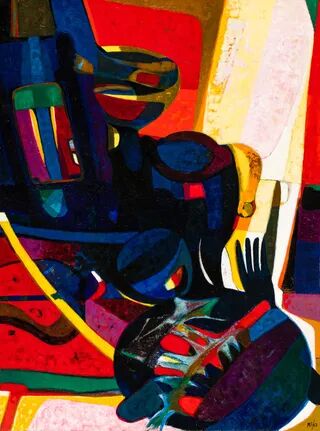
1936 - 2022 Visual Artist, Painter, Sculptor
Biography
Sándor Molnár was a Kossuth Prize-winning painter and sculptor, a prominent representative of the Hungarian neo avant-garde, and the founder of the Zuglói Circle. He graduated from the Secondary School of Fine and Applied Arts in 1954, where he was mentored by László Ridovics. He continued his studies at the Hungarian Academy of Fine Arts (1955-1961), under the guidance of János Kmetty, László Bencze, Géza Fónyi, and Bertalan Pór.
Around him, a group of friends interested in modern artistic styles formed, including Imre Bak, István Nádler, and Pál Deim. In 1958, he established the Zuglói Circle at his home. This circle engaged in theoretical and painting studies, analyzing each other's work. In 1962, Molnár wrote a theoretical and methodological study on the analysis of painterly elements.
He spent a year creating at the Kecskemét Artist Colony and then became acquainted with the philosopher Béla Hamvas. In 1965, he travelled to Paris, where he met Jean Bazaine and the group of young French painters known as the French Tradition. In 1966, he developed his unique painter-yoga theory. In 1982, he met Claude Viallat, a member of the Supports/Surfaces group. In 1986, he was invited as a guest professor to the art academy in Nîmes, and since 1990, he has been a university professor at the Hungarian University of Fine Arts. In 1993, he was elected a member of the Széchenyi Literary and Art Academy.
From his college years, he was interested not only in painting itself but also in theoretical questions about painting. In the late 1950s, he developed a so-called self-development program with the following main objectives:
- To understand contemporary artistic endeavours through painting practice.
- To acquire and translate writings by major contemporary universal painters.
- To become acquainted with avant-garde creators of the older generation, such as Tihamér Gyarmathy, Tamás Lossonczy, Ferenc Martyn, and Béla Veszelszky.
In 1955, he studied Buddhism and yoga and began painting abstract works in 1956. Since 1966, he has been an exhibiting artist with his first exhibition of lyrical abstract paintings in Budapest at the Mednyánszky Hall.
In the second half of the 1960s, he created a series of monochrome paintings, which Kmetty named Unikolor. He attempted to create a sense of spatial depth with colour processes, and these works were featured in the first Iparterv exhibition (1968).
In 1969, he developed painter-yoga and applied Béla Hamvas's theory about the genius of the Hungarian landscape. Monochrome paintings, which he referred to as "empty" works, were replaced by paintings transposing nature images into geometric structures. During this period, he created the Principium series, which he associated with the Earth element, painting Earth images until 1977.
Between 1978 and 1980, he did not use paint; influenced by the French Supports/Surfaces group, he filled the framed part of his paintings with ropes, canvases, and slats, forming them into images. From 1980, he entered the era of water operations, but by the mid-1980s, his works began to feature more shapes and motifs that were given meaning, and soon the fire element arrived.
In his pictures he depicted the purification of the soul and the struggle with inner forces with actual blazing flames. The Tumo series (Tumo, the fire of the soul, is a yogic test in Tibetan mysticism) overarched the fire period. The second phase of the fire motif involved reduction, with refined, enlightened forms replacing the uncontrollably blazing flames (passion). The third phase of the fire motif was sublimation, the structure of the quiet fading of fire.
During his fire period, he created a significant collection of sculptures. He incorporated found objects into his sculptures: bone, plaster, artificial leather, and sponge, all shaped into coherent works with artificial leather covering.
In the 2000s, he focused on the structural depiction of crystals, air, and complete abstraction (sunyata = emptiness).
2024
- Sándor Molnár: Landscapes (Solo Exhibition)
Einspach Fine Art&Photography, Budapest, Hungary
2022
- Sándor Molnár: Painter's Yoga (Solo Exhibition)
Műcsarnok, Budapest, Hungary - Allers / Retours 2016-2022 (Group Exhibition)
La Halle aux Poissons, Le Havre, France
2021
- Horizont (Group Exhibition)
REÖK Palota, Szeged, Hungary
2020
- Állapotfelmérés (Condition assessment) (Group Exhibition)
m21 Galéria, Pécs, Hungary
2019
- Chapter I. (Group Exhibition)
Einspach Fine Art & Photography, Budapest, Hungary - Iparterv 50+ (Group Exhibition)
Ludwig Museum, Budapest, Hungary
2018
- Private Storage (Group Exhibition)
Budapest Galéria, Hungary
2016
- Body, Fetish, Death (Group Exhibition)
Einspach Fine Art & Photography, Budapest, Hungary - śūnyatā (Group Exhibition)
Einspach Fine Art & Photography, Budapest, Hungary
2014
- Sándor Molnár: Plase şi încâlcitură (Solo Exhibition)
Galeria Helios, Timisoara, Romania
2011
- True Real World - 2011 (Group Exhibition)
Pécsi Galéria, Hungary
2009
- Márta’s Choice (Group Exhibition)
Galerie Terra, Delft, Netherlands - Sándor Molnár (Solo Exhibition)
Pécsi Galéria, Hungary
2006
- Sándor Molnár (Solo Exhibition)
Budapest Galéria, Budapest, Hungary
2005
- Corner Art (Group Exhibition)
Galeria Helios, Timisoara, Romania
2003
- Sándor Molnár - Crystal Pictures 1994-2002 (Solo Exhibition)
Ernst Museum, Budapest, Hungary
1995
- Sándor Molnár: Ceramic Artist (Solo Exhibition)
Szombathelyi Képtár, Hungary
1986
- Sándor Molnár (Solo Exhibition)
Szombathelyi Képtár, Hungary
PUBLIC COLLECTIONS
Hungary
- Janus Pannonius Museum, Pécs
- Kupferstich-Kabinett der Staalichen Kunstsammlungen, Dresden
- County Library, Békéscsaba, Hungary
- Hungarian National Gallery, Budapest
- Petőfi Literary Museum, Budapest, Hungary
- Szombathelyi Képtár, Szombathely, Hungary
- Museum of Fine Arts, Budapest, Hungary

